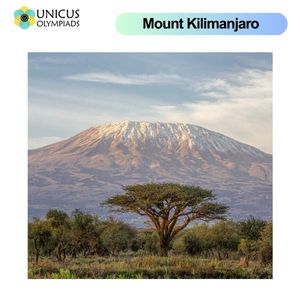

Mount Kilimanjaro is one of the most iconic and recognizable mountains in the world, towering over the African landscape with its snow-capped peak. It is the highest mountain in Africa and is located in the country of Tanzania. In this article, we will explore Mount Kilimanjaro’s location, significance, and the unique features that make it a natural wonder of the world.

Mount Kilimanjaro is located in the northeastern part of Tanzania, near the border with Kenya. The mountain is situated about 330 kilometers (205 miles) south of the equator, making it one of the most prominent geographical features in East Africa. It rises dramatically from the surrounding savanna plains, offering a stunning contrast between its icy peak and the tropical environment below.
Mount Kilimanjaro is part of the Mount Kilimanjaro National Park, a protected area established in 1973 to preserve the mountain’s unique ecosystems and to promote sustainable tourism. The park covers an area of about 1,688 square kilometers (652 square miles) and is home to diverse flora and fauna, ranging from tropical rainforests at lower elevations to alpine deserts at higher altitudes.
Mount Kilimanjaro is the tallest mountain in Africa, standing at an elevation of 5,895 meters (19,341 feet) above sea level. Its impressive height makes it a coveted peak for trekkers and mountaineers from around the world. Kilimanjaro is also one of the Seven Summits, a group of the highest mountains on each of the seven continents, making it a significant challenge for climbers who aim to complete this prestigious list.
One of the most remarkable features of Mount Kilimanjaro is its three volcanic cones:
Mount Kilimanjaro is famous for its climatic and ecological diversity. As climbers ascend the mountain, they pass through several distinct zones, each with its own unique ecosystem:
Climbing Mount Kilimanjaro is a popular activity for trekkers and mountaineers of varying skill levels. Unlike many other mountains, Kilimanjaro does not require technical climbing skills, making it accessible to people with limited mountaineering experience. The trek is challenging due to its high altitude, but it remains one of the most popular trekking destinations in the world. The climb typically takes around 5 to 9 days, depending on the route chosen and the acclimatization schedule.
The summit of Mount Kilimanjaro, known as Uhuru Peak, is a coveted destination for climbers. The word "Uhuru" means "freedom" in Swahili, and reaching the peak is considered a significant achievement. From the summit, climbers are treated to breathtaking views of the surrounding savanna and the distant Serengeti plains.
Mount Kilimanjaro holds deep cultural and spiritual significance for the people of Tanzania and East Africa. For centuries, it has been revered by local tribes, and many still consider it a sacred place. The mountain has been the subject of numerous myths, legends, and stories passed down through generations.
Mount Kilimanjaro is also vital for the environment, as its glaciers and snowfields feed into the surrounding rivers and ecosystems. The mountain provides a crucial water source for the region, supporting agriculture and wildlife. However, the glaciers on Kilimanjaro have been rapidly melting due to climate change, which poses a threat to the local environment and communities who depend on its resources.
Mount Kilimanjaro is a significant contributor to Tanzania’s economy, especially through tourism. Every year, thousands of climbers and tourists visit the mountain, generating revenue for the local economy. The presence of several national parks, including Kilimanjaro National Park, further enhances the economic importance of the mountain for the region.
One of the most pressing concerns for Mount Kilimanjaro is the impact of climate change. The mountain’s glaciers have been rapidly shrinking, and many of them are predicted to disappear in the coming decades. This is partly due to rising temperatures and altered rainfall patterns. The loss of glaciers threatens local ecosystems, as well as the livelihoods of people who rely on the mountain's water resources.
Efforts are being made to protect the mountain’s environment and preserve its natural beauty. Kilimanjaro National Park is actively involved in conserving the mountain’s ecosystems, and initiatives to monitor and address the impacts of climate change are underway. Sustainable tourism practices are also being promoted to reduce environmental degradation and ensure that future generations can experience the mountain in its full splendor.